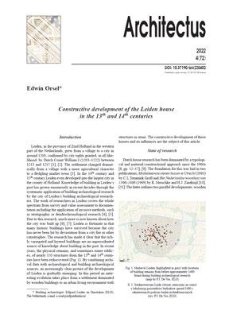Dolnośląska Biblioteka Cyfrowa udostępnia 109 387 obiektów cyfrowych
Obiekt
Tytuł: Constructive development of the Leiden house in the 13th and 14th centuries
Tytuł odmienny:
Rozwój konstrukcji domów w Lejdzie w XIII i XIV w.
Autor:
Współtwórca:
Opis:
Architectus : Pismo Wydziału Architektury Politechniki Wrocławskiej, 2022, nr 4 (72), s. 17-25
Abstrakt:
Wydawca:
Oficyna Wydawnicza Politechniki Wrocławskiej
Miejsce wydania:
Data wydania:
Typ zasobu:
Identyfikator zasobu:
doi:10.37190/arc220402 ; oai:dbc.wroc.pl:123834
Źródło:
<sygn. PWr A5234III> ; kliknij tutaj, żeby przejść ; www.architectus.arch.pwr.wroc.pl ; kliknij tutaj, żeby przejść
Język:
Powiązania:
Architectus : Pismo Wydziału Architektury Politechniki Wrocławskiej ; Architectus : Pismo Wydziału Architektury Politechniki Wrocławskiej, 2022, nr 4 (72)
Prawa:
Wszystkie prawa zastrzeżone (Copyright)
Prawa dostępu:
Dla wszystkich w zakresie dozwolonego użytku
Lokalizacja oryginału:
Tytuł publikacji grupowej:
Kolekcje, do których przypisany jest obiekt:
- Dolnośląska Biblioteka Cyfrowa > Uczestnicy Konsorcjum > 01. Politechnika Wrocławska > Czasopisma > Wydane w PWr > Architectus
- Dolnośląska Biblioteka Cyfrowa > Zasoby > 2. Czasopisma > Czasopisma współczesne
- Dolnośląska Biblioteka Cyfrowa > Dziedziny nauki > 2. Nauki inżynieryjno-techniczne
Data ostatniej modyfikacji:
13 wrz 2023
Data dodania obiektu:
13 wrz 2023
Liczba wyświetleń treści obiektu:
187
Wszystkie dostępne wersje tego obiektu:
https://dlibra.kdm.wcss.pl/publication/162110
Wyświetl opis w formacie RDF:
Wyświetl opis w formacie OAI-PMH:
| Nazwa wydania | Data |
|---|---|
| Constructive development of the Leiden house in the 13th and 14th centuries | 13 wrz 2023 |
Obiekty Podobne
Penther, Johann Friedrich (1693-1749)
Vitruvius Pollio, Marcus Rode, August. Tłumaczenie
Zubrzycki, Jan Sas (1860-1935)
Suckow, Lorenz Johann Daniel (1722-1801)
























